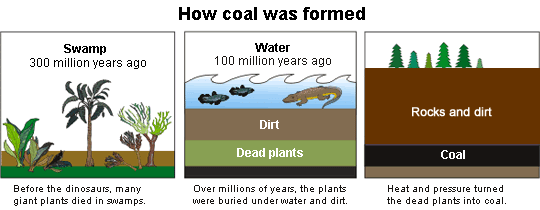ACE Report: How to Make a Fossil Fuel
Open Google Doc of How to Make a Fossil Fuel
By Rebecca Anderson, ACE Director of Education
The impetus for this came from a high school teacher at the California Science Teachers Association conference who pointed out to me that the story of how fossil fuels get made isn’t understood by most people.
That sparked my interest – How DO fossil fuels get formed? I know it has to do with organic matter decomposing and getting buried, but what kind of stuff and how does it work? Here’s what I found…
The science teacher was right (duh) – different fossil fuels are formed in pretty different environments. Oil and natural gas are formed primarily from ancient ocean environments. Coal mostly forms from a land environment, like a swamp. Originally, the main ingredient for oil and natural gas was tiny ocean critters called protoplankton – the early versions of the plankton we have in the ocean today (and the same stuff that pulls CO2 out of the seawater that I talked about in the ocean fertilization report).

Few fun facts about diatoms:
- There are over 100,000 species of diatoms.
- They make up about 45% (that’s almost HALF!) of the ocean’s primary production. (This is the first level of the food chain that pulls CO2 out of the water through photosynthesis and then provides food for everything else in the ocean.)
- As a group, they’ve been around since the Jurassic Period (150-200 million years ago) and are really good at telling us what climate was like in the past.
- People who study them are called diatomists! (I do know a few of these interesting folks personally.)
To eventually become fossil fuels, the diatoms / plankton die and their bodies fall to the seafloor. There they get buried under progressively more and more mud and sand until they end up deep enough under ground (several miles) to get baked into oil. The heat and pressure deep in the Earth does the trick, aided (I didn’t know this) by bacteria. Hotter and higher-pressure conditions produce natural gas; less intense conditions produce the oil. The last step in the process is that the oil and gas work their way up through fractures in the rock above until they get trapped under an impermeable layer called a cap rock – and that’s where they stay until people come along and suck them out.
Coal gets made through much the same processes, except that the original environment was more like a primordial (I love that word) swamp.

Here’s a diagram of the process from the Energy Information Administration’s Kids page.
One key point here is that most coal was formed between 300-400 million years ago, whereas dinosaurs didn’t really come along until about 245 million years ago.
Yeah, I know that’s only 65 million years apart, but that’s 65 million years apart!
What you can take away from all this is that there’s a LOT of work that goes into making this stuff. The environment has to be just right, plus you need a whole lot of time. This is why fossil fuels are called a nonrenewable resource — once they’re gone, they’re GONE. We’re not going to make any more for millions of years. So, as a long-term energy source, they just don’t make sense! Much smarter, in my mind, to get our energy from other sources, like wind and sun. They have the dual benefits of (1) they’re not contributing to climate change and (2) they’re not going anywhere anytime soon.
How to Make a Fossil Fuel
Student Worksheet
Name:
1. Why do fossil fuels have that name?
2. What was the original environment that oil and natural gas came from? What about coal?
3. What were the organisms that formed oil and gas called? Are they rare or common?
4. Explain in your own words how this plankton gets turned into oil or natural gas.
5. What causes natural gas to get created instead of oil?
6. Is it accurate to think of dinosaurs when we think of fossil fuels? What would be a better picture to imagine?
7. What makes fossil fuels a nonrenewable resource?
8. Eventually, we could run out of fossil fuels. What other sources of energy will last longer than fossil fuels?
